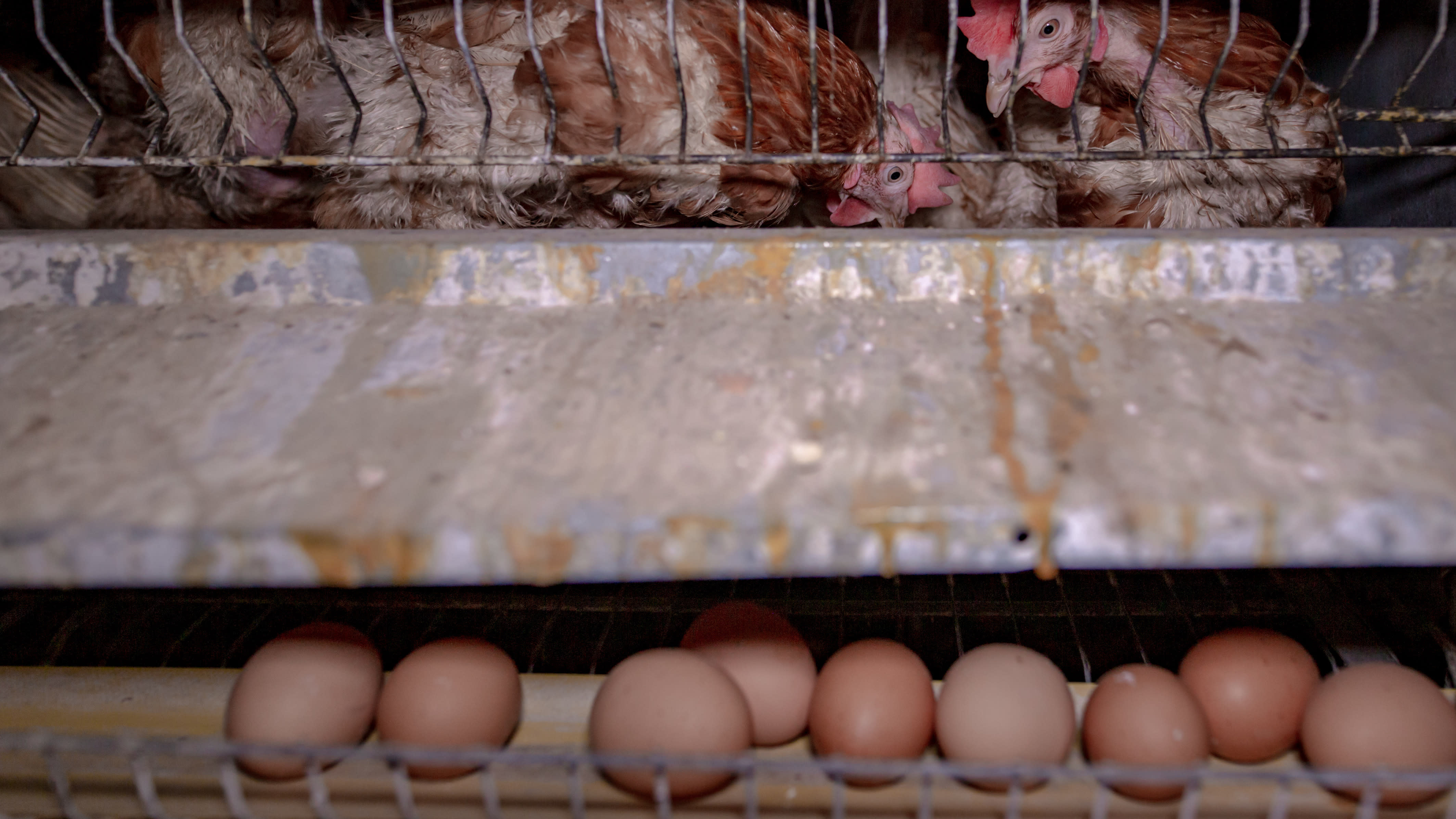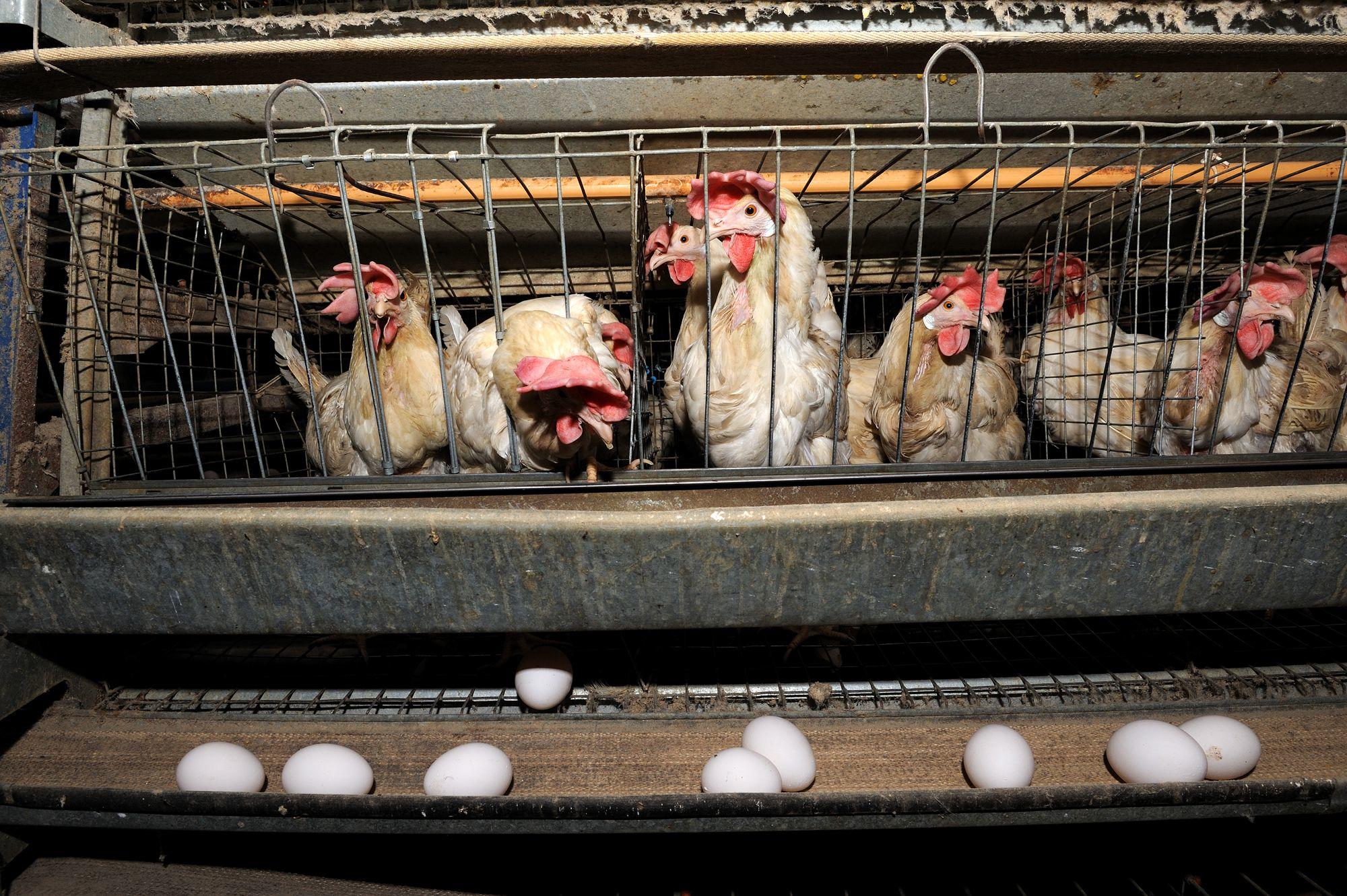




A hen’s closest wild ancestor, the red junglefowl, will produce 10-15 eggs in a year. A commercial egg-laying hen on a factory farm can produce around 300.

The process by which a chicken lays an egg might seem like magic. But in reality, every egg is the result of an orchestrated dance of hormones, complex internal processes, and minerals stored by the hen’s own body. In other words, laying an egg is hard work! And for modern commercial hens—who are selectively bred to lay as many eggs as possible—it can take an enormous toll.
How many eggs does a chicken lay a day?
Modern commercial laying hens, who have been selectively bred to lay as many eggs as possible, will generally produce one egg per day.
A lot of human intervention has gone into this number. Chickens have been bred over decades to be hyper-efficient at one of two things: 1) growing very large in a short amount of time, or 2) laying eggs. This has resulted in two main types of commercial chickens alive today—”broilers,” or chickens raised for meat, and egg-laying hens.
The entire egg-laying process takes just 25 hours for a commercial hen. It begins when her ovary creates a yolk, which then moves along her oviduct as an egg white (or albumen) develops around it. Next, the shell membrane forms. Finally, the eggshell is formed within the hen’s uterus, over the course of about 19 hours.
There’s a reason that forming the shell is the most time-intensive portion of the laying cycle. Eggshells are about 94% calcium carbonate, which hens absorb from their diets and store within their bones and digestive systems. But, according to the Welfare Footprint Project, a selectively bred egg-laying hen actually requires 30 times more calcium than her body can provide for the production of eggs. The extreme calcium demands of laying an egg every single day makes modern hens susceptible to osteoporosis, a condition that causes bone weakness and fragility. For hens housed in barren battery cages, the condition is even worse.
Each cage usually houses between four and ten hens, giving each hen a space the size of an iPad. That’s the space in which she’ll live her entire life. She can barely move, let alone spread her wings. The lack of exercise, coupled with near-constant egg laying, can lead to “cage layer fatigue”—a highly severe form of osteoporosis. Left untreated, cage layer fatigue can lead to bone fractures, spinal collapse, and even paralysis.
Sadly, many factory-farmed hens will suffer multiple bone fractures over the course of their lives. One such common fracture is the “keel bone,” a ridge where a hen’s wing muscles are attached. 50-99% of commercial hens will suffer keel bone lesions, which the Welfare Footprint Project describes as "the greatest source of physical pain that laying hens endure during their lives.”
How many eggs does a hen lay in a year naturally?
This is a tricky question, because there’s nothing “natural” about a modern-day laying hen—her very existence is the result of decades of human engineering. For a sense of what’s “natural,” we can look to her closest wild ancestor, the red junglefowl.
In the wild, the red junglefowl only lays around 12 eggs in an entire year. Contrast this with a modern commercial egg-laying hen on a factory farm, who will lay close to 300 eggs in a single year (a 2022 estimate placed the annual average production per layer at 285 eggs). And then, contrast these chickens’ lifespans. The red junglefowl can live 10-30 years. The commercial layer will be slaughtered at around two years old, when her rapid egg production starts to decline.
How many eggs does a chicken lay in a lifetime?
There’s no definitive estimate for how many eggs a chicken can lay in her lifetime. But given an average commercial hen’s egg production and lifespan, we can estimate that she will likely lay at least 330 eggs before she is slaughtered. This number is the result of industry practices that increase egg production at the expense of the birds.
Forced molting
There’s a lot of cruelty in the factory farming industry (to put it mildly). But when I first learned about forced molting in Jonathan Safran Foer’s book, Eating Animals, it was one of the practices that struck me the most. A poultry farmer describes the practice in an interview:
“[The birds are] put into barns and they lower the light; sometimes it’s total darkness twenty-four/seven. And then they put them on a very low-protein diet, almost a starvation diet. That will last about two or three weeks. Then they turn the lights on sixteen hours a day, or twenty with chickens, so she thinks it’s spring, and they put her on high-protein feed. She immediately starts laying. [...] After that first year, they are killed because they won’t lay as many eggs in the second year—the industry figured out that it’s cheaper to slaughter them and start over than it is to feed and house birds that lay fewer eggs.”
Maybe it’s because depriving someone of food and light seems like an effective form of psychological torture. But the idea of subjecting animals to long periods of light, darkness, and hunger—when they’ve already been deprived of so much—feels uniquely cruel.
Notably, forced molting is already illegal in some countries. The practice is banned in the EU, for example—as severe feed restriction and long periods of darkness are not permitted within EU legislation.
Food deprivation
Each year, with the transition of summer to fall, most hens naturally go through a molt—a process in which old, damaged feathers are replaced by new ones. As her body puts energy toward keeping warm and growing new feathers, a hen may naturally reduce egg production during the winter.
However, there’s no sign of the seasons in many modern egg operations. The facilities can be huge, windowless barns with no fresh air, no sunlight, and no indicators of the world outside. So, when hens’ egg production naturally tapers off, egg farmers may feed them an extremely low-energy diet for up to four weeks—creating the conditions for a “forced molt,” which will then kickstart one final cycle of egg production. During the starvation period, hens can lose up to 30% of their body weight.
Light manipulation
Like many animals, hens have their own seasonal rhythms—and their laying patterns are closely intertwined with the amount of light in their environment. Egg production naturally slows down in the winter, when the hours of daylight are shorter. When the days start becoming longer in the spring, hens begin laying more eggs again. This is because light stimulates the hen’s pituitary gland, releasing hormones for egg production.
Perhaps not surprisingly, factory farms have manipulated daylight’s natural rhythms for profit. Egg production facilities will keep lights bright for up to 16 hours a day, tricking hens’ bodies into laying a high volume of eggs year-round.
At what age do chickens stop laying eggs?
In egg production facilities, hens whose egg production has slowed down or stopped are considered “spent.” This usually happens at about 72 weeks old.
What is the average lifespan of a chicken?
The hen’s wild ancestor, the red junglefowl, can live for at least four years in the wild—and according to some sources, even up to 30 years. Domesticated backyard chickens, when allowed to live out their full lifespan, can live six to eight years. Sadly, on a factory farm, most commercial egg-laying hens are slaughtered by the time they’re two years old.
How can I help hens?
Hens are curious, intelligent beings with unique personalities. But, looking at an industrial egg operation, they seem like nothing more than egg-laying machines.
Thousands of people like you have already pressured major corporations to end some of the cruelest practices in the egg industry, including extreme confinement. Together, we can create a kinder world for hens. Will you add your voice?







